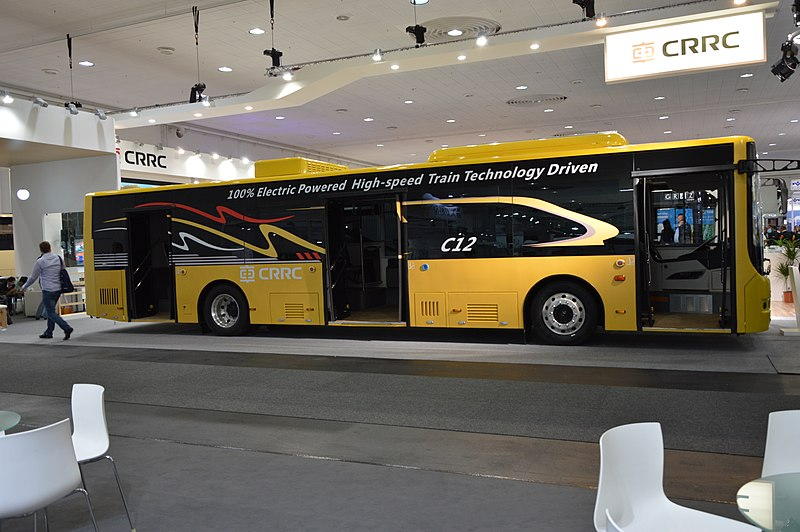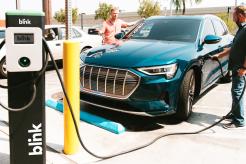A growing number of major US cities are exploring the many benefits of powering their public transit fleets with EV charging. Whether it’s saving money on fuel, providing their residents with cleaner air, or reducing noise pollution, it makes sense for city officials to consider a transition to an all-EV fleet.

Image via Wikimedia Commons
If you’re trying to convince city governments to consider adding EVs to their public fleets, showcase the cities that have made the transition with great success. Discover what the top US cities with EV public transit fleets across the nation have done to introduce their residents to all the perks EVs bring to the table.
Anaheim Transportation Network
Anaheim, a bustling Southern California city just outside Los Angeles, has enjoyed such success in its quest to save on fuel costs by switching part of its fleet to EVs that it doubled its EV charging capacity in early 2023. As part of its goal to have an all-electric fleet by 2026, the city partnered with bp pulse to construct a temporary charging facility from two repurposed shipping containers.
Not only does this temporary facility provide additional power for the city’s growing fleet now, but it will also serve as a second EV charging station after the city completes its permanent facility. With a 10-million-strong customer base and LA next door, Anaheim’s commitment to a clean-air transit service will likely make the region a cleaner place to live.
Santa Barbara Metropolitan Transit District
With its coastal charm and Spanish heritage, Santa Barbara is a fabulous place for both visitors and permanent residents. Now, with two new zero-emission buses and 14 stations to charge them, the ocean breezes will be cleaner than ever, thanks to the Santa Barbara Metropolitan Transit District (MTD) and its partners. Each bus represents approximately 50% reduction in CO2 emissions versus their diesel predecessors.
The partnership — a combination of local government officials, nonprofit organizations, EV charging infrastructure executives, bus manufacturers, and SoCal Edison — plans to work toward an all-zero-emission fleet by 2030. This move only continues the city’s leadership in the electrified public transit space, a commitment it has upheld since 1991.
To meet that goal, the MTD plans to add nine more 40-foot zero-emission buses and 14 30-foot buses to its fleet.
Boise’s Valley Regional Transit
Although Idaho’s reputation for clean mountain air could lead one to wonder why the city’s Valley Regional Transit (VRT) took the fast track to EV adoption, the reality is quite a different story — at least in the state’s capital, Boise. As the United States’ fifth fastest-growing city, those new faces and the fossil fuel-powered cars they drive have driven air pollution to higher levels than ever before.
Boise’s location in the Treasure Valley between two mountain ranges tends to trap pollutants in the air, especially during the winter, when wood-burning stoves spew out even more particulates into the air. Combined with the growing population’s vehicle emissions, the city’s air pollution presents a challenge that the VRT stepped up to meet.
Launching a marketing campaign that positioned its first four new electric buses as superheroes fighting pollution, the VRT has grown its electric fleet to 12 — all with flashy designs that attract residents to choose public transit over firing up their gas- or diesel-powered cars. So far, the VRT’s campaign has proven successful. Its plans include replacing all its 54 diesel-powered vehicles with EVs.
The Anchorage Climate Action Plan

Image via Freepik
Like Idaho, Alaska has a reputation for clean air and pristine scenery. Anchorage, the state’s largest city, wanted to keep it that way.
Introducing a pilot program that measured the efficiency of electric buses in the area’s brutal winters, the city leaders soon discovered that with proper maintenance, these zero-emission vehicles do indeed rival diesel buses as transit workhorses. Through that program, the Anchorage officials learned that by replacing one diesel bus with an EV, they could eliminate 250,000 lb. of carbon in a single year.
That’s all they needed to launch a full-scale implementation of electric vehicles across the state — not only in public transit but also in public works, law enforcement, and educational fleets. By 2030, the plan projects, public fleets across the state should number in the tens of thousands.
Central Florida Regional Transportation Authority (LYNX)

Image via Wikimedia Commons
Unlike Alaska, cities in sunny Florida need not concern themselves about EVs’ cold-weather performance. The state’s reputation as a tourist haven and winter home for the nation’s retirees, though, presented a challenge of its own — a need for dependable public transportation that wouldn’t poison the air for its growing population.
Dipping into the state’s Volkswagen settlement distribution, Florida awarded over $68 million to 13 counties to build out their public transit fleets with electric vehicles. The Central Florida Regional Transportation Authority (LYNX), which governs the transportation system for Orlando and surrounds, received $9 million of that amount.
Even before the 2022 Volkswagen settlement funding, LYNX had a mission to provide residents and tourists with “environmentally friendly transportation services.” With a goal to end 2020 with half its public transit fleet battery-powered electric buses and the rest compressed natural gas-fueled vehicles, LYNX rolled out its first electric bus by the end of spring that same year.
Fast forward to September 2023. As the Orlando Sentinel’s Kevin Spear points out, nearly gone are the “flags of black diesel exhaust” the city’s buses used to spew along a collection of routes that spans three counties. In fact, Spear reports, the Central Florida bus system is well on its way to phasing out its diesel buses by 2025, three years earlier than its previous goal of 2028, thanks to its aggressive EV adoption program.
Discover More About the Benefits EV Charging Can Bring to Public Transit

Image via Freepik
At the EV Charging Summit, you’ll get to meet some of the minds behind some of the public transit world’s transition to electric-powered vehicles, including Diana Kotler, an EV thought leader whose Anaheim Transportation Network we featured earlier in this post, and representatives from the Santa Barbara Metropolitan Transit District, also featured in this post.
Our track-based format allows you to tailor your experience to your specific interests, giving you the exact information you need to further your business’s or government office’s drive toward EV adoption. Don’t miss your chance to discover the latest developments in the EV charging space. Register for your place at the table today!






